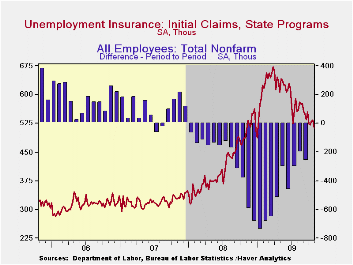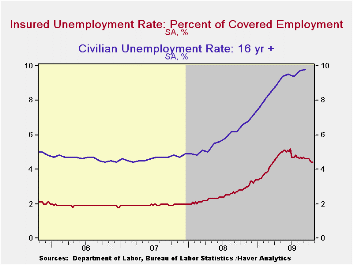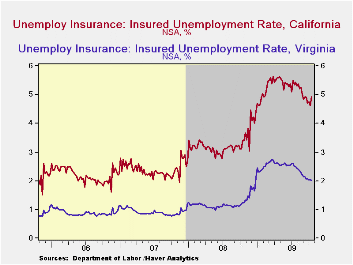 Global| Nov 05 2009
Global| Nov 05 2009U.S. Weekly Initial Claims For Unemployment Insurance Lowest Since January
by:Tom Moeller
|in:Economy in Brief
Summary
The Labor Department indicated that initial claims for unemployment insurance fell moderately to 512,000 last week from a little-revised 532,000. The latest figure represented material labor market improvement since it was the lowest [...]
 The Labor
Department indicated that initial claims for unemployment insurance
fell moderately to 512,000 last week from a little-revised 532,000. The
latest figure represented material labor market improvement since it
was the lowest since the first week of January. Moreover, claims have
fallen sharply from the peak reached in March of 674,000 claims. The
four-week moving average of claims fell to 523,750 and the latest
weekly figure was lower than Consensus expectations for 520,000
claims.
The Labor
Department indicated that initial claims for unemployment insurance
fell moderately to 512,000 last week from a little-revised 532,000. The
latest figure represented material labor market improvement since it
was the lowest since the first week of January. Moreover, claims have
fallen sharply from the peak reached in March of 674,000 claims. The
four-week moving average of claims fell to 523,750 and the latest
weekly figure was lower than Consensus expectations for 520,000
claims.
 Continuing claims for unemployment insurance during the latest
week fell 68,000 to their lowest level since late-March. The decline
reflects the improved job market but may also be a function of the
exhaustion of benefits. Continuing claims provide an indication of
workers' ability to find employment. The four-week average of
continuing claims fell modestly to 5,886,250 and have fallen 13.0% from
their peak. This series dates back to
1966.
Continuing claims for unemployment insurance during the latest
week fell 68,000 to their lowest level since late-March. The decline
reflects the improved job market but may also be a function of the
exhaustion of benefits. Continuing claims provide an indication of
workers' ability to find employment. The four-week average of
continuing claims fell modestly to 5,886,250 and have fallen 13.0% from
their peak. This series dates back to
1966.
Extended benefits for unemployment insurance rose moderately and reversed half of the prior week's decline. Through early-October extended benefits averaged 551,355.
 The insured rate of
unemployment held steady at 4.4% and matched its lowest since
late-March. The rate reached a high of 5.2% during late-June. During
the last ten years, there has been a 93% correlation between the level
of the insured unemployment rate and the overall rate of unemployment
published by the Bureau of Labor Statistics.
The insured rate of
unemployment held steady at 4.4% and matched its lowest since
late-March. The rate reached a high of 5.2% during late-June. During
the last ten years, there has been a 93% correlation between the level
of the insured unemployment rate and the overall rate of unemployment
published by the Bureau of Labor Statistics.
The highest insured unemployment rates in the week ending October 17 were in Puerto Rico (6.4%), Nevada (5.4), Oregon (5.4), California (4.9), Pennsylvania (4.9), Arkansas (4.8), Wisconsin (4.8), Michigan (4.7), Alaska (4.6), North Carolina (4.6), and South Carolina (4.6). The lowest insured unemployment rates were in North Dakota (1.0%), South Dakota (1.1), Virginia (2.0), Wyoming (2.8), Maine (2.5), Texas (2.5), Colorado (3.0), Maryland (3.0), Mississippi (3.6), New York (3.5), Florida (3.7), and Georgia (3.8).
The unemployment insurance claims data is available in Haver's WEEKLY database and the state data is in the REGIONW database.
Asia Recovering Rapidly, but Faces Challenges, says IMF from the International Monetary Fund can be found here
| Unemployment Insurance (000s) | 10/30/09 | 10/23/09 | 10/16/09 | Y/Y | 2008 | 2007 | 2006 |
|---|---|---|---|---|---|---|---|
| Initial Claims | 512 | 532 | 531 | 4.9% | 420 | 321 | 313 |
| Continuing Claims | -- | 5,749 | 5,817 | 49.0% | 3,342 | 2,552 | 2,459 |
| Insured Unemployment Rate (%) | -- | 4.4 | 4.4 | 2.8 (10/2008) | 2.5 | 1.9 | 1.9 |
Tom Moeller
AuthorMore in Author Profile »Prior to joining Haver Analytics in 2000, Mr. Moeller worked as the Economist at Chancellor Capital Management from 1985 to 1999. There, he developed comprehensive economic forecasts and interpreted economic data for equity and fixed income portfolio managers. Also at Chancellor, Mr. Moeller worked as an equity analyst and was responsible for researching and rating companies in the economically sensitive automobile and housing industries for investment in Chancellor’s equity portfolio. Prior to joining Chancellor, Mr. Moeller was an Economist at Citibank from 1979 to 1984. He also analyzed pricing behavior in the metals industry for the Council on Wage and Price Stability in Washington, D.C. In 1999, Mr. Moeller received the award for most accurate forecast from the Forecasters' Club of New York. From 1990 to 1992 he was President of the New York Association for Business Economists. Mr. Moeller earned an M.B.A. in Finance from Fordham University, where he graduated in 1987. He holds a Bachelor of Arts in Economics from George Washington University.






